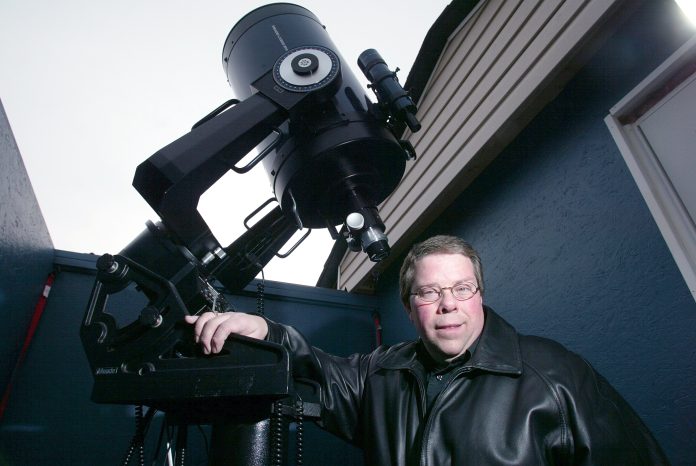Science
Interstellar Object 3I Atlas Sparks Curiosity and Debate

Scientists are closely monitoring an intriguing interstellar object known as 3I Atlas, which is on a trajectory that raises significant questions about its origin and behavior. Expected to make its closest approach to Earth on December 19, 2023, passing at a distance of approximately 400 million kilometers, Atlas is unlike anything modern astronomy has encountered. Its unusual characteristics have captured the attention of astronomy educator Gary Boyle, who has described the object as a catalyst for public curiosity.
Unusual Trajectory and Behavior
Boyle, who is recognized as The Backyard Astronomer and is a former president of the Royal Astronomical Society of Canada Ottawa Centre, noted that Atlas appears to be traveling from the Milky Way constellation of Sagittarius. This trajectory is particularly noteworthy as it is within nine degrees of the location from which the WOW signal was detected in 1977. “The path seems to be coming from the middle of the Milky Way, which is pretty odd,” he explained.
Initially classified as a comet, Atlas has exhibited behavior that defies conventional expectations. Boyle pointed out that the object displayed an anti-tail, a phenomenon where the tail points toward the sun, which is rarely observed in comets. “For its first couple of months, it had only an anti-tail and no normal tail at all,” he said, stressing that this raises questions about its true nature.
As Atlas approaches the sun, further anomalies have emerged. The object has shown multiple color changes and has been observed to emit seven jets, which Boyle suggested could either be natural outgassing or resemble thrusters found on spacecraft. “Could these jets be thrusters like we have in our spacecraft?” he pondered. “So many odd things.”
Perhaps the most perplexing aspect of Atlas is its non-gravitational acceleration. Rather than slowing down as it passes by the sun, the object is inexplicably speeding up. While natural comets can show minor deviations due to gas jets, Boyle remarked that the scale of Atlas’s behavior is unusual, prompting further investigation.
The Search for Clarity
Despite the growing interest, no major observatory has released high-resolution images of Atlas. This absence of data has sparked debate within the scientific community. According to reports, the Mars Reconnaissance Orbiter captured detailed images of the object on October 2 and 3, 2023, but the data has not been made available due to the recent United States government shutdown. Boyle emphasized the importance of these images, stating, “The scientific community is waiting to see those clear pictures.”
Some scientists, notably Avi Loeb, a Harvard astrophysicist, have been vocal in urging NASA to release the images. Loeb has suggested that Atlas could potentially be a probe or vehicle, a viewpoint that has caused some contention within the scientific community. “Even Avi Loeb from Harvard is saying it could be an interstellar vehicle or a probe,” Boyle noted, while British physicist Brian Cox dismissed the speculation, arguing that it detracts from reliable data.
The ongoing discourse highlights a more profound question regarding humanity’s understanding of interstellar visitors. When asked about the possibility of alien technology being involved, Boyle offered a measured response. “Alien technology could be underlying,” he stated. He elaborated that extraterrestrial life might not conform to human expectations, suggesting that unexplored physics could be at play.
Boyle referenced the concept of dimensions beyond human perception, likening it to Carl Sagan‘s illustration of Flatland. “Maybe aliens work on a different frequency that we cannot move into yet,” he speculated.
Public Curiosity and Future Developments
The potential for public intrigue surrounding 3I Atlas is significant. In Saskatchewan, where amateur astronomy thrives thanks to dark skies, interest has surged as news of the object spreads. Boyle noted that curiosity peaks during unusual celestial events, and Atlas could serve as a gateway to greater public engagement in science. “If we can get more people interested in sciences such as this, who knows what that could lead to?” he remarked.
As the scientific community awaits the release of the unreleased images, the implications of Atlas’s behavior could lead to answers or further inquiries. “Stay tuned,” Boyle advised. “This might be real.” While the interstellar visitor will continue its journey back into deep space, the questions it raises may endure, shaping humanity’s understanding of the cosmos. Boyle concluded, “Of 400 billion stars in the Milky Way, there must be life somewhere. It’s really hard to argue we are the only ones.”
-

 Education3 months ago
Education3 months agoBrandon University’s Failed $5 Million Project Sparks Oversight Review
-

 Science4 months ago
Science4 months agoMicrosoft Confirms U.S. Law Overrules Canadian Data Sovereignty
-

 Lifestyle3 months ago
Lifestyle3 months agoWinnipeg Celebrates Culinary Creativity During Le Burger Week 2025
-

 Health4 months ago
Health4 months agoMontreal’s Groupe Marcelle Leads Canadian Cosmetic Industry Growth
-

 Science4 months ago
Science4 months agoTech Innovator Amandipp Singh Transforms Hiring for Disabled
-

 Technology4 months ago
Technology4 months agoDragon Ball: Sparking! Zero Launching on Switch and Switch 2 This November
-

 Education4 months ago
Education4 months agoRed River College Launches New Programs to Address Industry Needs
-

 Technology4 months ago
Technology4 months agoGoogle Pixel 10 Pro Fold Specs Unveiled Ahead of Launch
-

 Business3 months ago
Business3 months agoRocket Lab Reports Strong Q2 2025 Revenue Growth and Future Plans
-

 Technology2 months ago
Technology2 months agoDiscord Faces Serious Security Breach Affecting Millions
-

 Education4 months ago
Education4 months agoAlberta Teachers’ Strike: Potential Impacts on Students and Families
-

 Education3 months ago
Education3 months agoNew SĆIȺNEW̱ SṮEȽIṮḴEȽ Elementary Opens in Langford for 2025/2026 Year
-

 Science4 months ago
Science4 months agoChina’s Wukong Spacesuit Sets New Standard for AI in Space
-

 Business4 months ago
Business4 months agoBNA Brewing to Open New Bowling Alley in Downtown Penticton
-

 Business4 months ago
Business4 months agoNew Estimates Reveal ChatGPT-5 Energy Use Could Soar
-

 Technology4 months ago
Technology4 months agoWorld of Warcraft Players Buzz Over 19-Quest Bee Challenge
-

 Business4 months ago
Business4 months agoDawson City Residents Rally Around Buy Canadian Movement
-

 Technology4 months ago
Technology4 months agoFuture Entertainment Launches DDoD with Gameplay Trailer Showcase
-

 Technology2 months ago
Technology2 months agoHuawei MatePad 12X Redefines Tablet Experience for Professionals
-

 Top Stories3 months ago
Top Stories3 months agoBlue Jays Shift José Berríos to Bullpen Ahead of Playoffs
-

 Technology4 months ago
Technology4 months agoGlobal Launch of Ragnarok M: Classic Set for September 3, 2025
-

 Technology4 months ago
Technology4 months agoInnovative 140W GaN Travel Adapter Combines Power and Convenience
-

 Science4 months ago
Science4 months agoXi Labs Innovates with New AI Operating System Set for 2025 Launch
-

 Technology4 months ago
Technology4 months agoNew IDR01 Smart Ring Offers Advanced Sports Tracking for $169








